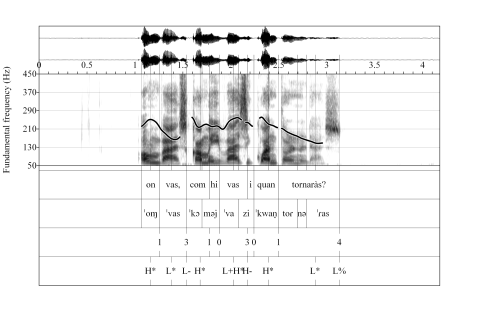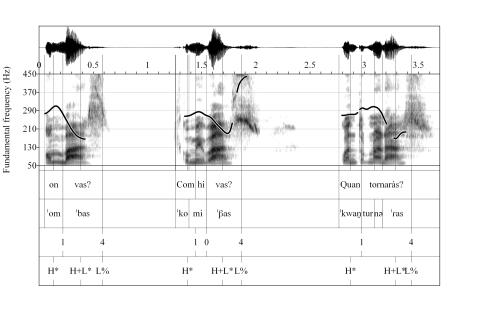There are some phenomena which may appear within an intonational phrase, IP but not across different IPs. So, on the one hand, a BI 4 inhibits the application of many sandhi rules such as vowel deletion, vowel coalescence, gliding, and fricative voicing.
On the other hand, a BI 4 is accompanied by rhythmic cues: it is the domain for pre-boundary lengthening, and it defines the position for pauses.
Finally, it has a precise intonational definition. The IP is the domain of the minimal tune: it consists of one or more pitch accents plus boundary tones. Thus, a BI 4 is always accompanied by the presence of boundary tones.
There are several arguments in favour of a level for an intonationally-defined constituent underneath the intonational phrase: the intermediate phrase (ip).
The first argument is a perceptual one. In Catalan prosodic transcriptions, transcribers clearly distinguish between two levels of degree of perceived disjuncture. The end of the weaker disjuncture corresponds to a level 3 break index in the ToBI system, while the strong disjuncture corresponds to a level 4 break index.
The second argument relates to intonational marking. Like the intonational phrase, the intermediate phrase is tonally marked after its final pitch accent (yet not as strongly as the intonational phrase), but the inventory of boundary tones that appear in this position is of a different (but partially overlapping) class. Typically, H- boundary tones, also called continuation rises, mark the end of an intermediate phrase.
Frota, D’Imperio, Elordieta, Prieto & Vigário (2007) examined the phonetics and phonology of prosodic boundaries in such positions in five Romance languages, among them Catalan. They found that the two dominant boundary tones in statements (located at the end of the first prosodic constituent) were either the continuation rise or the sustained pitch. By contrast, intonational phrase-final edges were generally signalled by a low boundary tone (L%) and by a wider inventory of boundary tone combinations.
BI 3
Break indices of level 3BI 3) correspond to the end of minor prosodic units: they mark the boundaries of intermediate phrases, ips.
BI 4
Break indices of level 4 (BI 4) correspond to the end of major prosodic units: they mark the boundaries of intonational phrases, IPs.
Example BI 3
Example BI 4
On vas, com hi vas i quan tornaràs?
[Where are you going, how are you getting there and when will you be back?]

On vas? Com hi vas? Quan tornaràs?
[Where are you going? How are you getting there? When will you be back?]

Explanations
These two examples correspond to very similar sentences but with two different prosodic organizations. (The first one was uttered by a Catalan speaker from Manacor, Majorca, and the second one from Barcelona). Both contain six prosodic words assembled in three higher prosodic constituents. In both examples, each of these three prosodic constituent ends with a boundary tone.
In the second one, all of these boundary tones are followed by a pause, and the three prosodic constituents are independent IPs. So their edges must be marked by BI 4.
On the contrary, the first two boundary tones of the first example are not followed by any pause, and they correspond to boundaries that do not prohibit the application of sandhi rules: notice the fricative voicing at the end of the second prosodic constituent. So the whole sentence contains a unique IP made of three ips. Thus the boundaries between the first and the second ip, and between the second and the third ip must be marked by a BI 3. Of course, the third ip ends with a pause and its right edge coincides with the right edge of the IP, so it must be marked by a BI 4.
